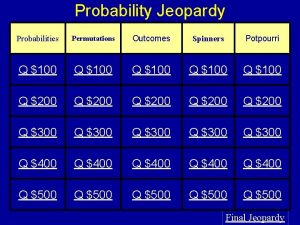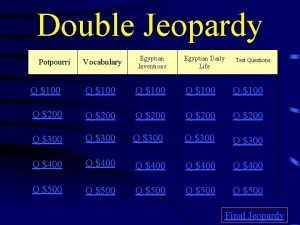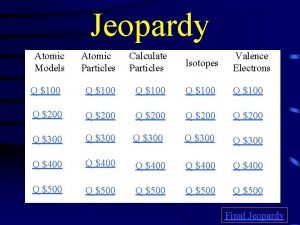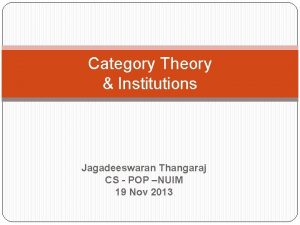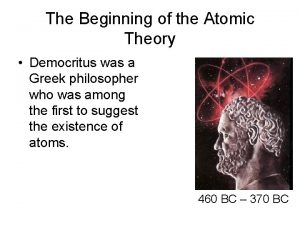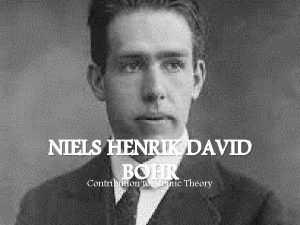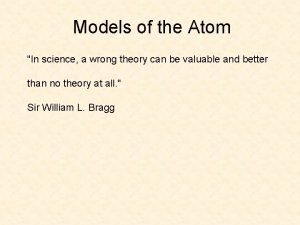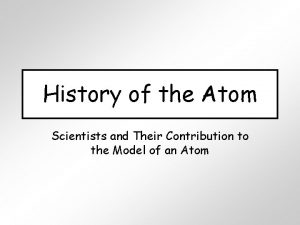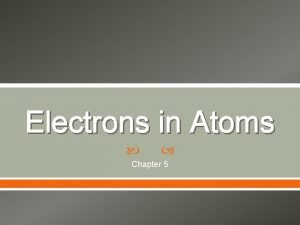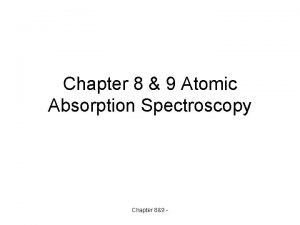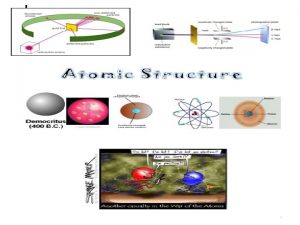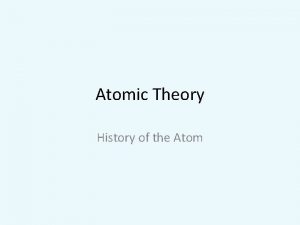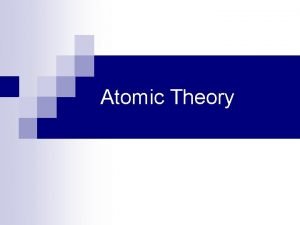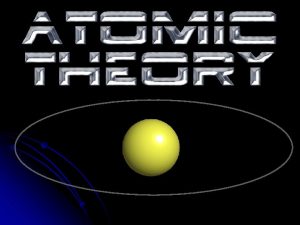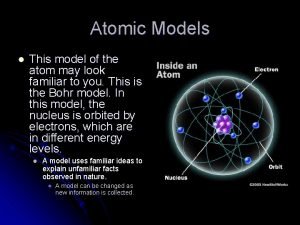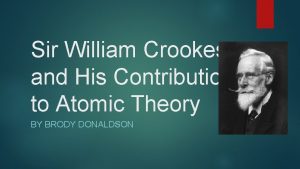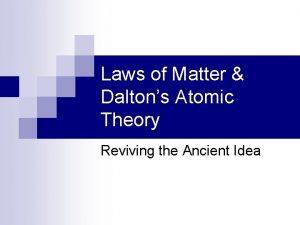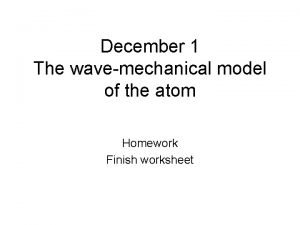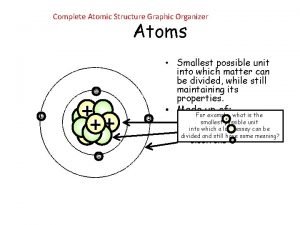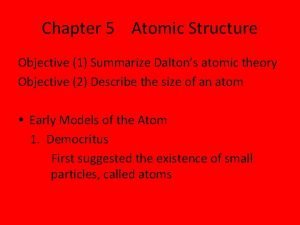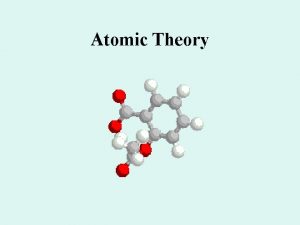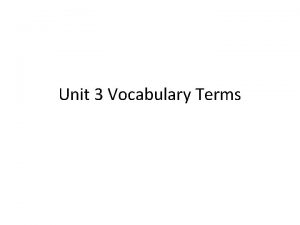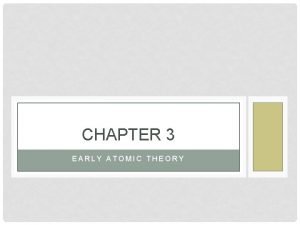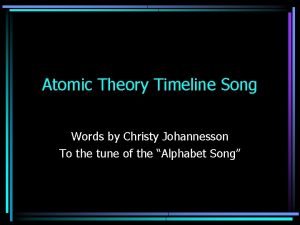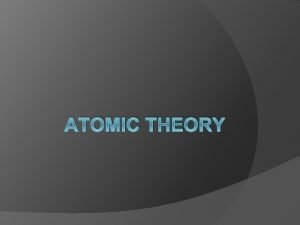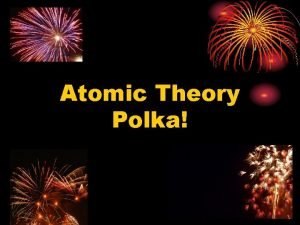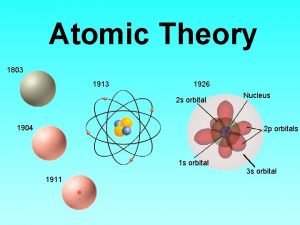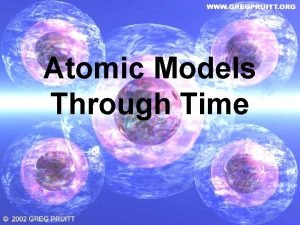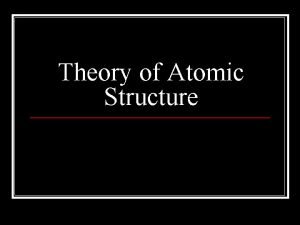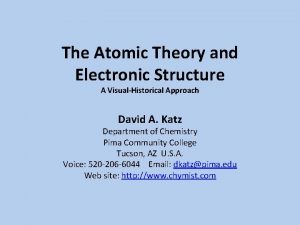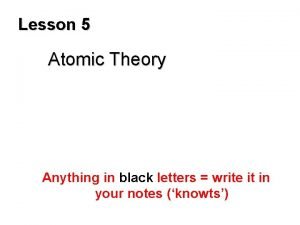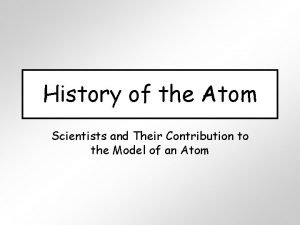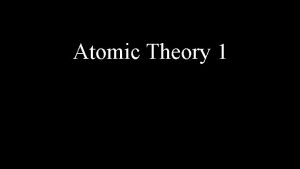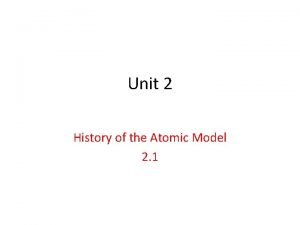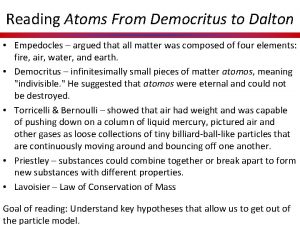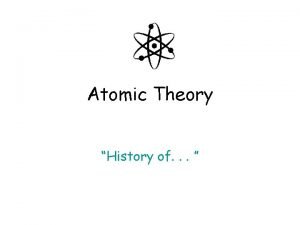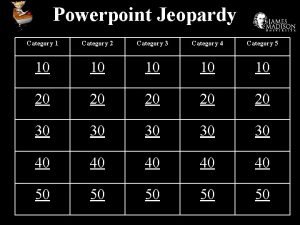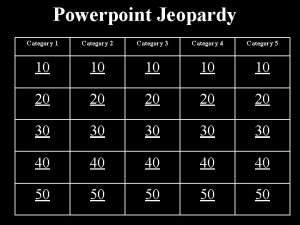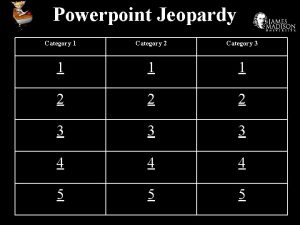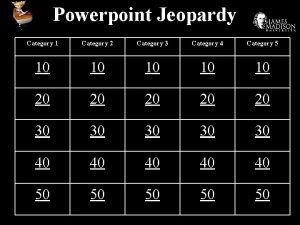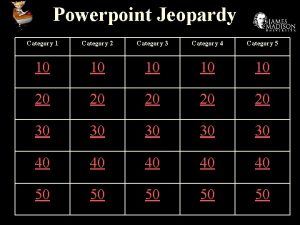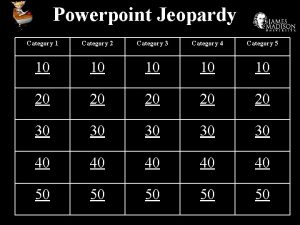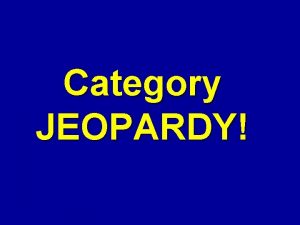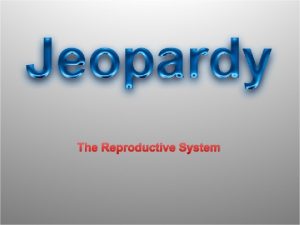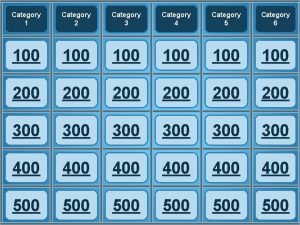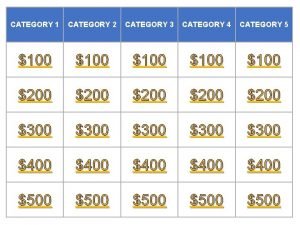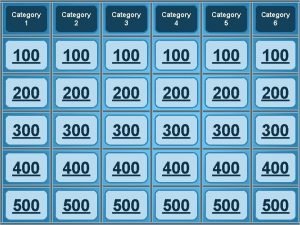Powerpoint Jeopardy Category 1 Atomic Theory Category 2



















































- Slides: 51

Powerpoint Jeopardy Category 1 Atomic Theory Category 2 Chemistry & Energy Category 3 Organic Molecules Category 4 Inorganic Molecules Category 5 Organic or Inorganic? 15 15 15 25 25 25 50 50 50 75 75 75 100 100 100

1. The smallest particle of an element that retains the properties of that element is ______. A Valence electrons. B Ions. C Atoms. D Protons. Category 1 15 points Answer. . .

C. ATOMS 15 points Home

15. Which of the following statements is correct regarding the location of subatomic particles: A. electrons are found inside the atomic nucleus and protons and neutrons are found outside the atomic nucleus B. protons and neutrons are found inside the atomic nucleus and electrons are found outside the atomic nucleus C. protons and electrons are found inside the atomic nucleus and neutrons are found outside the atomic nucleus Category 1: 25 points. Answer. . .

B. protons and neutrons are found inside the atomic nucleus and electrons are found outside the atomic nucleus 25 points Home

Name the four elements that appear in 96% of the body. a. b. c. d. N, P, C, H, A, N N, C, H, O Na, C, H, O Category 1 50 points Answer. . .

c. C, H, O, N 50 points Home

DOUBLE JEOPARDY! : ) The number of ______ determines the atomic number an atom has. A. electrons (only) B. protons (only) C. neutrons (only) D. A and B (only) E. B and C (only) F. Atomsthe atomic number an atom has. Category 1 75 x 2 = 150 points Answer. . .

DOUBLE JEOPARDY! : ) B. protons (only) Category 1 75 x 2 = 150 points Home

What is the element that makes something organic? a. Calcium – Ca b. Lithium – Li c. Hydrogen – H d. Carbon – C Category 1 100 points Answer. . .

D. Carbon – C 100 points Home

_____ are proteins that speed up a chemical reaction. A. Collagen B. Keratin C. Enzymes D. Substrates Category 2 15 points Answer. . .

enzymes Category Two - 15 points Home

Which of the following combinations of terms is correct? A. Solute + Solvent = Solution B. Solute + Solution = Solvent C. Solution + Solvent = Solute Category 2 25 points Answer. . .

A. Solute + Solvent = Solution Category Two - 25 points Home

What type of energy occurs when the sun hits your skin? A. Chemical B. Radiant C. Electrical D. Mechanical Category 2 50 points Answer. . .

Radiant energy Category Two - 50 points Home

True (A) or False (B): A chemical change does not alter the basic nature of the substance. Category 2 75 points Answer. . .

B. False Category Two - 75 points Home

What is the major difference between kinetic and potential energy? A. There is no major difference. B. Kinetic energy is stored and potential energy is due to gravity. C. Kinetic Energy is moving energy is potential energy is stored energy. D. Kinetic energy is inert energy and potential energy is moving energy. Category 2 100 points Answer. . .

C. Kinetic Energy is moving energy is potential energy is stored energy. Category Two - 100 points Home

Lipids contain which elements? A. C, H, O (Only) C. Hydrogen and Nitrogen (Only) B. Carbon and Oxygen (Only) D. C, H, O, N (Only) Answer. . . Category 3 Quadruple Jeopardy 4 x 15 = 60 points

A. C, H, O Category Three - 60 points Home

Which of the following is NOT a function of DNA? A. Controls enzyme productions C. Determines inherited characteristics B. Controls metabolism D. Codes for intermediate steps in protein synthesis. Answer. . . Category 3 Double Jeopardy! 2 x 25= 50 points

D. Codes for intermediate steps in protein synthesis. Category Three - 25 points Home

Lipid molecules… . A. are the building blocks of C. are inorganic. cellular membranes. B. are the body’s most readily available energy source. D. contains the genetic information found in cells. Category 3 50 points Answer. . .

A. are the building blocks of cellular membranes. Category Three - 50 points Home

Predict the combination of nucleotides for DNA: TTAGC A. TTAGC C. AATCG B. UUTCG D. GGCTA Category 3 Double Jeopardy 2 x 75 = 150 points Answer. . .

C. AATCG Category Three - 150 points Home

Which of the following statements about Adenosine Triphosphate is true? A. Provides instruction for every protein B. Replicates before cell division C. Carries out orders issued for protein synthesis D. Chemical energy used by cells Category 3 100 points Answer. . .

D. Chemical energy used by cells Category Three - 100 points Home

What is the body’s p. H? A. 4 B. 7 C. 9 D. 0 Category 4 15 points Answer. . .

7 Category Four - 15 Points Home

Which type of organic compound provides all types of cells energy? a. Carbohydrates b. Salts c. Lipids d. Water Category 4 25 points Answer. . .

Carbs A Category Four - 25 points Home

Acid or Base? Proton donator A. Acid B. Base Category 4 50 points Answer. . .

ACID Home

Water is useful in body processes because: A. B. C. D. it has a high heat capacity it is chemically inert it is a good solute it acts as an enzyme Category 4 75 points Answer. . .

A. It has a high heat capacity Category 4 - 75 points Home

The type of carbohydrate that consists of double chains of linked simple sugars is: A. Disaccharides C. Glycogen B. Monosaccharides D. Polysaccharides Category 4 100 points Answer. . .

A. Disaccharides Category Four - 100 points Home

Which ORGANIC compound is the most abundant in the body? A. Lipids B. Carbohydrates C. Water D. Protein Category 5 QUADRUPLE JEOPARDY ! : ) Answer. . . 15 x 4 = 60 points

PROTEINS Category Five - 60 Points Home

What is the major difference between organic and inorganic molecules? A. They both contain carbon. C. Neither molecules contain carbon. B. Only inorganic D. Only organic compounds molecules contain carbon. Category 5 25 points Answer. . .

D. Only organic compounds contain carbon. Category Five - 25 Points Home

Which of the following is an organic molecule? A. Fats B. Acids C. Water D. Salts Category 5 50 points Answer. . .

A. Fats (Lipids) Category Five - 50 Points Home

Which INORGANIC compound is the most abundant in the body? A. B. C. D. Acids Bases Salts Water Category 5 75 points Answer. . .

WATER Category Five - 75 points Home

Organic Molecules include which numbers? 1. Water 3. Amino Acids 2. Fats 4. Monosaccharides A. 1 and 3 only B. 1 and 2 only C. 2 and 3 only D. 2, 3, and 4 only Category 5 100 points Answer. . .

D. 2, and 3, and 4 Fats (lipids) Amino acids Monosaccarides (carbs) Category Five - 100 Points Home
 Pa erate
Pa erate Relative formula mass of hcl
Relative formula mass of hcl What are the trends in the periodic table
What are the trends in the periodic table Atomic radius periodic table
Atomic radius periodic table How to calculate abundance of isotopes
How to calculate abundance of isotopes Atomic mass and atomic number difference
Atomic mass and atomic number difference Atomic number vs atomic radius
Atomic number vs atomic radius Jeopardy category names
Jeopardy category names Potpourri category jeopardy
Potpourri category jeopardy Inventions jeopardy questions
Inventions jeopardy questions How many neutrons does francium have
How many neutrons does francium have Equaliser category theory
Equaliser category theory Democritus atomic model diagram
Democritus atomic model diagramSir james chadwick atomic theory
 Democritus atomic model
Democritus atomic model Contribution of neil bohr in chemistry
Contribution of neil bohr in chemistry Erwin schrödinger model of atom
Erwin schrödinger model of atom Schrodinger atomic theory
Schrodinger atomic theory Atomic theory timeline
Atomic theory timeline Dalton atomic theory summary
Dalton atomic theory summary Theory of atomic absorption spectroscopy
Theory of atomic absorption spectroscopy 70ga protons neutrons electrons
70ga protons neutrons electrons Democritus atomic theory model
Democritus atomic theory model John dalton atomic theory timeline
John dalton atomic theory timeline Father of atomic theory
Father of atomic theory Atomic model history
Atomic model history Neils bohr
Neils bohr Atomic molecular theory
Atomic molecular theory Sir james chadwick atomic theory
Sir james chadwick atomic theory William crookes contribution to atomic theory
William crookes contribution to atomic theory Dalton's atomic theory was accepted because
Dalton's atomic theory was accepted because Erwin schrödinger atomic theory
Erwin schrödinger atomic theory Complete atom
Complete atom Summarize dalton's atomic theory
Summarize dalton's atomic theory Atoms graphic organizer
Atoms graphic organizer Atomic theory vocabulary
Atomic theory vocabulary Robert millikan atomic model
Robert millikan atomic model Democtritus
Democtritus Whats the atomic theory
Whats the atomic theory Atomic theory polka
Atomic theory polka 1926 atomic theory
1926 atomic theory John dalton atomic theory
John dalton atomic theory When did leucippus discover the atomic theory
When did leucippus discover the atomic theory Isaac newton atom
Isaac newton atom Wilhelm roentgen atomic theory
Wilhelm roentgen atomic theory James chadwick contribution to atomic theory
James chadwick contribution to atomic theory Jj thomson atomic theory
Jj thomson atomic theory Hans geiger atomic theory
Hans geiger atomic theory Democritus and dalton
Democritus and dalton Nuclide symbol
Nuclide symbol Ancient greek atomic model
Ancient greek atomic model Cornelia m. ruland and shirley m. moore
Cornelia m. ruland and shirley m. moore








